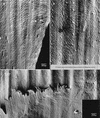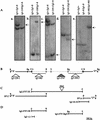The maize gene liguleless2 encodes a basic leucine zipper protein involved in the establishment of the leaf blade-sheath boundary
- PMID: 9490265
- PMCID: PMC316436
- DOI: 10.1101/gad.12.2.208
The maize gene liguleless2 encodes a basic leucine zipper protein involved in the establishment of the leaf blade-sheath boundary
Abstract
The blade and sheath of a maize leaf are separated by a linear epidermal fringe, the ligule, and two wedge-like structures, the auricles. In plants homozygous for the null mutation, liguleless2-reference (lg2-R), the ligule and auricles are often absent or positioned incorrectly and the blade-sheath boundary is diffuse. This phenotype is in contrast to that of liguleless1-reference (lgl-R) mutant plants, which have a more defined boundary even in the absence of the ligule and auricles. Additionally, mosaic analysis indicates the lg2-R phenotype is cell-nonautonomous and the lg1-R phenotype is cell-autonomous. Using scanning electron microscopy we show that lg2-R mutant plants are affected before the first visible sign of ligule and auricle formation. We have cloned the Lg2+ gene through a Mutator-8 transposon insertion allele, and verified it with five independently derived alleles. The comparison of genomic DNA and cDNA sequences reveals an open reading frame encoding a protein of 531 amino acids with partial homology to a subclass of plant basic leucine zipper (bZIP) transcription factors. Although a large body of molecular and biochemical characterization exists on this subclass of bZIP proteins, our work represents the first report of a mutant phenotype within this group. A specific reverse transcriptase (RT)-PCR assay shows LG2 mRNA expression in meristem/developing ligule regions. RT-PCR also shows that LG2 mRNA accumulation precedes that of LG1 mRNA. The mutant phenotype and expression analysis of lg2 suggest an early role in initiating an exact blade-sheath boundary within the young leaf primordia.
Figures







References
-
- Altschul SF, Gish W, Miller W, Myers EW, Lipman DJ. Basic local alignment search tool. J Mol Biol. 1990;215:403–410. - PubMed
-
- Becraft PW, Bongard-Pierce DK, Sylvester AW, Poethig RS, Freeling M. The liguleless-1 gene acts tissue specifically in maize leaf development. Dev Biol. 1990;141:220–232. - PubMed
-
- Bohmann D, Bos TJ, Admon A, Nishimura T, Vogt PK, Tjian R. Human proto-oncogene c-jun encodes a DNA binding protein with structural and functional properties of transcription factor AP-1. Science. 1987;238:1386–1392. - PubMed
Publication types
MeSH terms
Substances
Associated data
- Actions
LinkOut - more resources
Full Text Sources
Molecular Biology Databases
